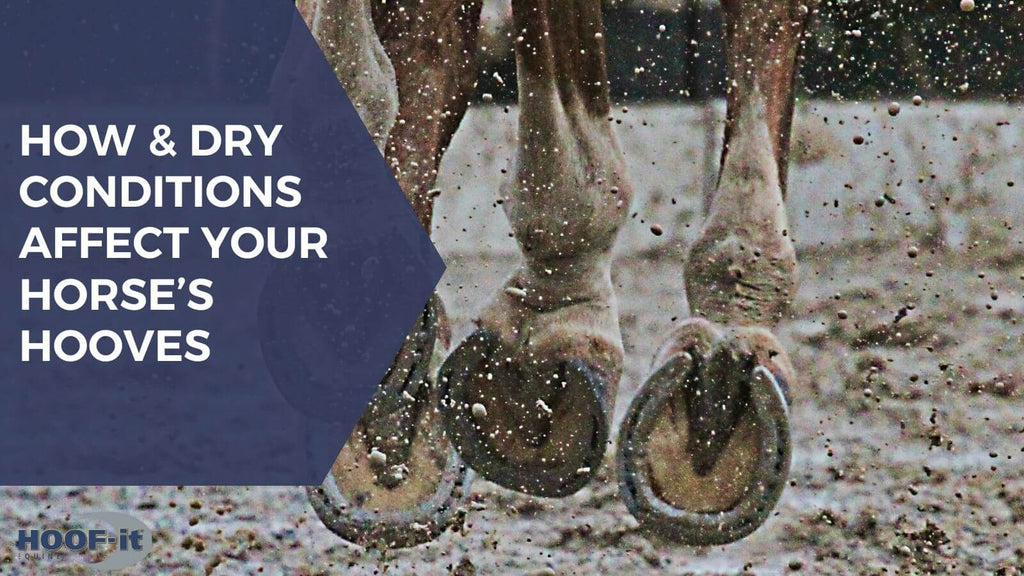The Delicate Balance: How Wet and Dry Conditions Affect Your Horse’s Hooves
Ah, the weather! It’s the one thing we horse owners love to complain about but have absolutely no control over. Yet, when it comes to our horses’ hooves, weather conditions can be more than just a minor inconvenience—they can be the difference between healthy, happy hooves and a painful trot down lameness lane. So, let’s dive into the world of wet and dry conditions and how they play tug-of-war with your horse’s feet.
The Impact of Wet Conditions
When Mother Nature decides to let loose with her rain and moisture, your horse’s hooves are on the front line. Extended exposure to wet conditions can lead to a few challenges:
-
Softened Hooves: Just like how your skin gets pruney after soaking in a bath too long, your horse’s hooves can become overly soft when exposed to wet conditions. This softening weakens the hoof wall, making it more susceptible to cracks, chips, and splits. Not to mention, a softer hoof is more prone to bruising, which can lead to soreness or even lameness.
-
Thrush and Bacterial Infections: Wet environments are breeding grounds for bacteria and fungi. When hooves stay damp, especially in muddy conditions, the likelihood of developing thrush or other bacterial infections skyrockets. Thrush is a particularly nasty infection that loves to settle in the frog area, causing pain and a foul odor. If left untreated, it can become severe enough to cause lameness.
-
Muddy Messes: Let’s not forget the sheer inconvenience of muddy pastures. When hooves are caked in mud, it’s not just messy—it can trap moisture against the hoof, exacerbating the softening and increasing the risk of bacterial infections. Plus, muddy conditions can cause horses to slip, leading to strains or injuries.
The Dry Spell: What Happens in Arid Conditions
On the flip side, when the rain stops and the sun beats down, we’ve got a whole new set of hoof challenges to contend with:
-
Brittle Hooves: Prolonged exposure to dry, arid conditions can have the opposite effect on hooves—they become too hard and brittle. A dry hoof is less flexible and more prone to cracks, chips, and even painful conditions like hoof abscesses. Brittle hooves also have a harder time absorbing shock, which can lead to soreness after work on hard ground.
-
Contracted Hooves: In extremely dry conditions, hooves can start to contract, leading to a tighter, less pliable structure. This contraction can cause discomfort, especially when a horse is asked to perform on hard surfaces. Over time, contracted hooves may also lead to changes in gait and posture, putting undue stress on joints and tendons.
-
Slow Growth: Dry conditions can also slow down hoof growth, which might sound like a blessing if you’re tired of frequent farrier visits. However, slow growth can be a problem if your horse has a hoof condition that requires regular trimming or if they’re recovering from an injury.
Finding the Balance: What Can You Do?
As horse owners, we can’t control the weather, but we can take steps to manage the effects of wet and dry conditions on our horse’s hooves:
-
Regular Farrier Visits: Keeping up with regular farrier appointments is crucial, regardless of the weather. A skilled farrier can help address the unique challenges that wet or dry conditions bring, whether it’s trimming away damaged hoof wall or advising on the best treatments for thrush.
-
Proper Hoof Care: In wet conditions, ensure hooves are cleaned and dried thoroughly after turnout. Consider using a topical hoof dressing that helps repel moisture. In dry conditions, moisturizing hoof products can help maintain flexibility and prevent brittleness.
-
Stable Management: When possible, provide your horse with a dry, clean place to stand, especially during prolonged wet weather. Conversely, in dry conditions, consider turning out during cooler parts of the day when the ground isn’t as hard.
-
Diet and Supplements: A balanced diet with the right nutrients is key to healthy hoof growth, no matter the weather. Consider adding a hoof supplement rich in biotin, zinc, and methionine to support hoof health from the inside out.
Wrapping Up
So, whether it’s a downpour or a drought, the weather plays a significant role in the health of your horse’s hooves. By staying proactive and adapting your care routine to the conditions at hand, you can keep those hooves strong, healthy, and ready to tackle whatever Mother Nature throws your way.
Remember, the key is balance—just like in riding, finding that sweet spot between wet and dry is essential for hoof health. Keep an eye on the forecast, listen to your farrier’s advice, and give your horse the hoof care they need to stay comfortable and sound all year round.

